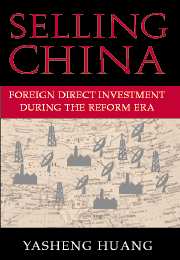Book contents
- Frontmatter
- Contents
- List of Tables and Figures
- List of Abbreviations
- Synopsis of the Book
- Preface
- Selling China
- 1 Introduction
- 2 An Analytical Framework
- 3 Problems in China's Corporate Sector
- 4 Constraints on Nonstate Firms and Foreign Direct Investment
- 5 State-Owned Enterprises and Insolvency-Induced Foreign Direct Investment
- 6 Economic Fragmentation and Foreign Direct Investment
- 7 Conclusion
- Bibliography
- Index
4 - Constraints on Nonstate Firms and Foreign Direct Investment
Published online by Cambridge University Press: 05 June 2012
- Frontmatter
- Contents
- List of Tables and Figures
- List of Abbreviations
- Synopsis of the Book
- Preface
- Selling China
- 1 Introduction
- 2 An Analytical Framework
- 3 Problems in China's Corporate Sector
- 4 Constraints on Nonstate Firms and Foreign Direct Investment
- 5 State-Owned Enterprises and Insolvency-Induced Foreign Direct Investment
- 6 Economic Fragmentation and Foreign Direct Investment
- 7 Conclusion
- Bibliography
- Index
Summary
In a 1998 interview, in response to the question of why he decided to form a JV in 1991 with COSMOS Machinery International Co. Ltd., a trading firm based in Hong Kong, Bao Zhishu, the Suzhou entrepreneur we encountered in Chapter 3, had this to say:
We were a collective firm. The state did not invest in us at all. But our products were very advanced. An advanced firm needs a lot of capital. We needed an advanced working environment. Could we ask for funding from the state? Of course not. At that time, the state would not pay attention to whether you were a good or a bad firm. There was no money for you if you were a collective firm. Everything was by the book. The machine-tools industry was a priority industry for the state. There were seven or eight firms in the country producing products similar to ours. They were all SOEs. We were ranked the last.
To secure funding, Bao's firm, Sanguang, a precision machine-tools producer, formed a JV with COSMOS, which earlier had acted as an agent abroad for a state-owned machine-tools firm in Suzhou. COSMOS came into contact with Sanguang by chance when the manager of COSMOS visited his state-owned supplier. At the time, Sanguang was selling all its output on the domestic market.
- Type
- Chapter
- Information
- Selling ChinaForeign Direct Investment During the Reform Era, pp. 151 - 211Publisher: Cambridge University PressPrint publication year: 2002



